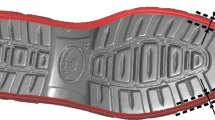Abstract
With the development of computer-aided design (CAD) technology and increasing demands of customized footwear, shoe-lasts are requested to be designed rapidly so as to speed-up the process of footwear manufacturing. Thus, this study presents a CAD system for shoe-last rapid customized design based on the piecewise reconstruction to realize the interactive deformation and separate/global shoe-last form reuse. First, piecewise remodeling method is proposed based on the multi-layer parametric definition and contour curves are extracted from the mesh. Then, five types of proper constraints to support surface manipulation are proposed, and the draft-driven deformation by the contour curve bending can realize the interactive local surface design in free angle of view. Finally, shoe-last styles can be saved and reused globally or separately to share design results between different shoe-lasts. Experimental examples show that customized shoe-lasts can be easily and rapidly generated by adopting the parametric design methods.
Similar content being viewed by others
References
Barnett L, Rahimifard S, Newman S (2004) Distributed scheduling to support mass customization in the shoe industry. Int J Comput Integ M 17(7):623–632. doi:10.1080/09511920412331292628
Du X, Jiao J, Tseng MM (2006) Understanding customer satisfaction in product customization. Int J Adv Manuf Technol 31:396–406. doi:10.1007/S00170-005-0177-8
De Rossi N, Rossi A, Trevisani A, Zanotto V (2002) Development and performance assessment of a laser triangulation scanner for digitizing shoe lasts. In Proceedings of AMST 2002, Udine, Italy, July 2002, pp 553–560
Lin J, Jiang K, Liu B, Huang C (2008) Rapid registration for 3D data with overlapping range based on human computer interaction. In: Global design to gain a competitive edge. Springer-Verlag London Ltd, Surrey, England, pp 651–659. doi:10.1007/978-1-84800-239-5_64
Luximon A, Goonetilleke RS, Tsui KL (2003) Foot landmarking for footwear customization. Ergonomics 46(4):364–383. doi:10.1080/0014013021000045225
Zhao J, Xiong S, Bu Y, Goonetilleke RS (2008) Computerized girth determination for custom footwear manufacture. Comput Ind Eng 54(3):359–373. doi:10.1016/j.cie.2007.07.015
Cheng F, Perng DB (1999) A systematic approach for developing a foot size information system for shoe last design. Int J Ind Ergonom 25(2):171–185. doi:10.1016/S0169-8141(98)00098-5
Mochimaru M, Kouchi M, Dohi M (2000) Analysis of 3-D human foot forms using the free form deformation method and its application in grading shoe lasts. Ergonomics 43(9):1301–1313. doi:10.1080/001401300421752
Kos L, Duhovnik J (2002) A system for footwear fitting analysis. Seventh International Design Conference. Croatia, Dubrovnik, pp 1187–1192
Witana CP, Feng J, Goonetilleke RS (2004) Dimensional differences for evaluating the quality of footwear fit. Ergonomics 47(12):1301–1317. doi:10.1080/00140130410001712645
Peng W, Xu F, Zhang W (2009) Fuzzy comprehensive evaluation of shoes comfort based on shoe last. International Symposium on Information Proceeding. Huangshan, China, pp 250–253
Olivato P, Morricone M, Fubini E, Re A (2007) Foot digitalization for last design and individual awareness of personal foot characteristics. 1st International conference on digital human modeling. Beijing, China, pp 949–958. doi:10.1007/978-3-540-73321-8_107
Xiong S, Goonetilleke RS, Witana CP, Au EYL (2008) Modelling foot height and foot shape-related dimensions. Ergonomics 51(8):1272–1289. doi:10.1080/00140130801996147
Leng J, Du R (2005) A deformation method for shoe last customization. Comput Aided Des Appl 2(1–4):11–18
Leng J, Du R (2006) A CAD approach for designing customized shoe last. Comput Aided Des Appl 3(1–4):377–384
Shi H, Wang B, Jia Q, Luo X (2009) Segment-based adaptive modification for customized shoe last. Optics and Precision Engineering 17(4):880–885
Xiong S, Zhao J, Jiang Z, Dong M (2010) A computer-aided design system for foot feature-based shoe last customization. Int J Adv Manuf Technol 46(1–4):11–19. doi:10.1007/s00170-009-2087-7
Shi N, Yi S, Xiong S, Jiang Z (2009) A CAD System for Shoe Last Customization. 2009 International Symposium on Applied Computing and Computational Sciences, 24–26 April, Sanya, Hainan Island, China, pp 957–960. doi:10.1109/CSO.2009.229
Liu H, Chen L, Ye X, Pan X, Xu Q (2007) Parameterized freeform shape design and deformation. International Conference on Multimedia and Ubiquitous Engineering, Seoul, South Korea, pp 626–632
Kim S, Mazumder MMG, Park SJ (2007) A last design with uniform foot pressure free form deformation. 11th international conference on intelligent engineering systems. Budapest, Hungary, pp 89–92. doi:10.1109/INES.2007.4283678
Luximon A, Luxinmon Y (2009) Shoe-last design innovation for better shoe fitting. Comput Ind 60(8):621–628. doi:10.1016/j.compind.2009.05.015
Yau HT, Chen JS (1997) Reverse engineering of complex geometry using rational B-splines. Int J Adv Manuf Technol 13:548–555. doi:10.1007/BF01176298
Kim SH, Shin KH (2009) A method for deforming a surface mmodel using guide surfaces in shoe design. Int J Adv Manuf Technol 42:60–72. doi:10.100./S00170-008-1578-2
Hu J, Shen H, Zeng S, Wang Y (2006) B-spline tool offset of a free-form curve in the shoe last high-speed maching CNC system. Int J Adv Manuf Technol 30:864–869. doi:10.1007/S00170-005-0129-3
Hwang TJ, Lee K, Oh HY, Jeong JH (2005) Derivation of template shoe-lasts for efficient fabrication of custom-ordered shoe-lasts. Comput-Aided Des 37(12):1241–1250. doi:10.1016/j.cad.2004.12.002
Lu G, Chen J, Wang J (2006) Research of shoe last RP based on CAD/CAM integration. Machinery 33(9):28–40, In Chinese
Wang M, Lu G, Zhang D (2007) 3D human reconstruction and animation in garment CAD. J Eng Graph 1:1–6, In Chinese
Author information
Authors and Affiliations
Corresponding author
Rights and permissions
About this article
Cite this article
Wang, J., Zhang, H., Lu, G. et al. Rapid parametric design methods for shoe-last customization. Int J Adv Manuf Technol 54, 173–186 (2011). https://doi.org/10.1007/s00170-010-3144-y
Received:
Accepted:
Published:
Issue Date:
DOI: https://doi.org/10.1007/s00170-010-3144-y




